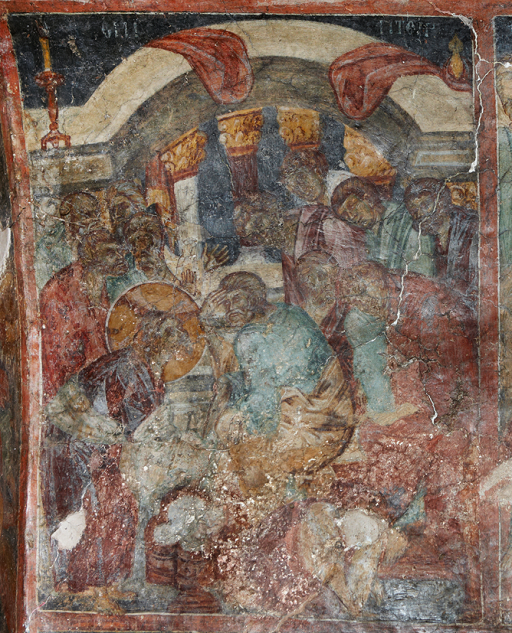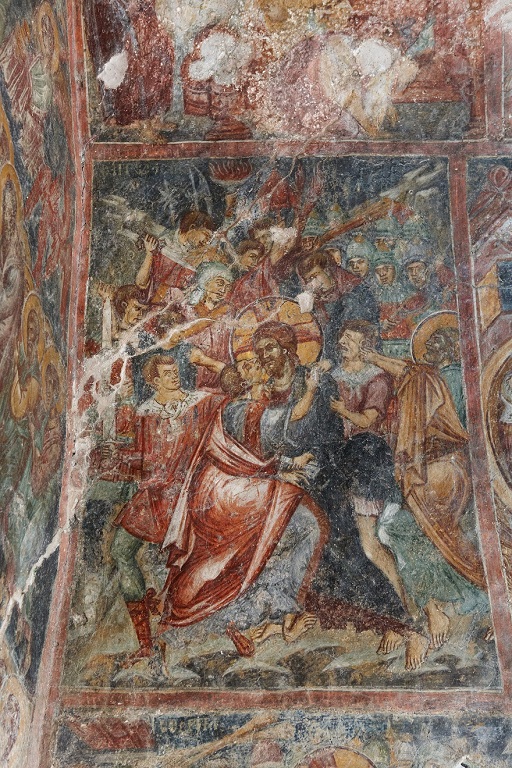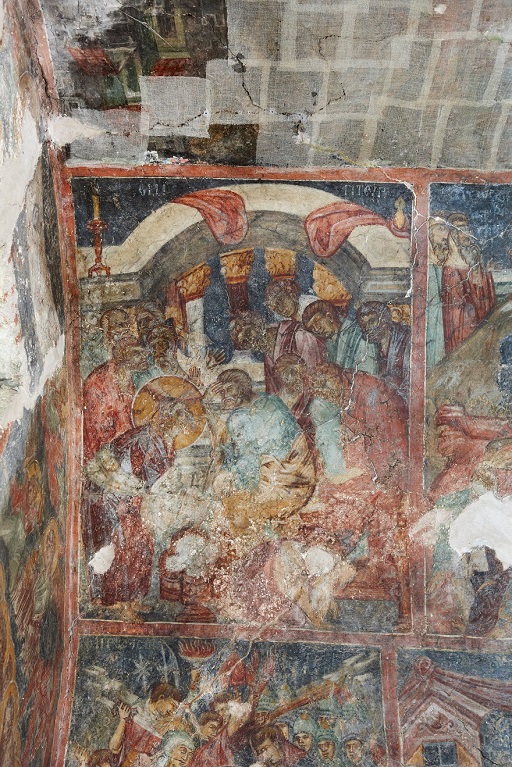4 The Washing of the Feet
A wall painting depicting the Washing of the Feet is situated on the north wall in the church of Christ, in the village of Potamies, in the prefecture of Herakleion, on the island of Crete. Looking back to Week 1, Section 3.4, this church was decorated when the island was under Venetian rule. And – again referring back to Week 1, Section 3.2 – it is part of the second zone of a church’s hierarchical construction, as it represents a scene of the life of Christ, who in this particular case is also the patron, since the church is dedicated to Christ. The scene illustrates the moment Christ washed the disciples’ feet before the Last Supper.
Activity 2 The Washing of the Feet
Look closely at Figure 12 alongside the Gospel narrative. Make a note of the details visualised in the scene.

John 13:3-11
3 Jesus knowing that the Father had given all things into his hands, and that he was come from God, and went to God;
4 He riseth from supper, and laid aside his garments; and took a towel, and girded himself.
5 After that he poureth water into a bason, and began to wash the disciples’ feet, and to wipe them with the towel wherewith he was girded.
6 Then cometh he to Simon Peter: and Peter saith unto him, Lord, dost thou wash my feet?
7 Jesus answered and said unto him, What I do thou knowest not now; but thou shalt know hereafter.
8 Peter saith unto him, Thou shalt never wash my feet. Jesus answered him, If I wash thee not, thou hast no part with me.
9 Simon Peter saith unto him, Lord, not my feet only, but also my hands and my head.
10 Jesus saith to him, He that is washed needeth not save to wash his feet, but is clean every whit: and ye are clean, but not all.
11 For he knew who should betray him; therefore said he, Ye are not all clean.
Comment
The scene is set within an architectural setting, which implies that it takes place inside. The disciples are depicted seated around the table, gesticulating, and are either looking on (disciples on the right) or talking to each other (disciples on the left). The Gospel narrative focuses on the dialogue between Christ and Saint Peter, and Peter’s initial objection to what Christ is about to do. The two protagonists occupy the foreground of the scene, with Christ seen to the left, holding a towel as mentioned in the narrative, and Saint Peter to the right, sitting with his feet in the basin, also mentioned in the narrative. Byzantine iconography always depicts Peter’s objection with him raising an arm (in this scene his right) to his forehead. This could be both an indication of Peter’s initial bewilderment and subsequent acceptance (specifically mentioning his hands and head) as mentioned in the narrative.
As another indication of the sophistication of Byzantine iconographic programmes, this particular scene is situated directly above the scene of the Betrayal in the same church (see Figures 10 and 13). In Matthew 26:25, Judas is mentioned by name as the one who betrayed Christ, and this exact same scene is depicted directly below in the church at Potamies, bringing the relation between written and visual ‘words’ into sharp focus.


